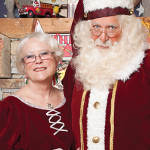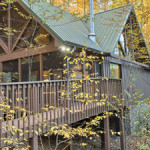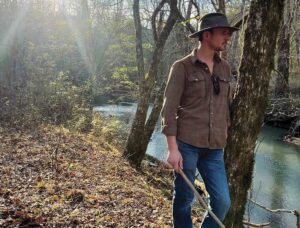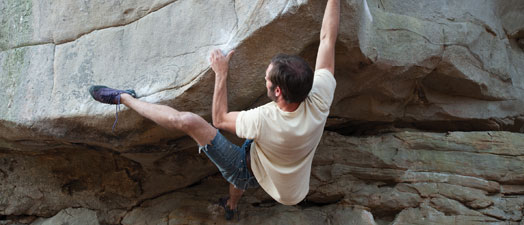
Horse Pens 40 part
of epic competition
Story and photos by Wallace Bromberg Jr.
Horse Pens 40, high atop Chandler Mountain, is a destination point, or you might say a series of destination points, for boulder climbers from around the country, Canada and beyond.
As home to one of the finest sandstone bouldering fields in North America, climbers from as far away as Colorado, Quebec, California, Virginia and South Florida come to compete in the HP40 segment of the Triple Crown Bouldering competition.
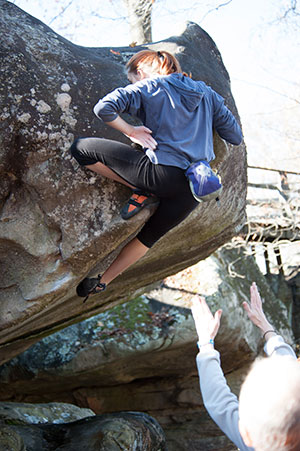 The Triple Crown is the brain child of Jim Horton of North Wilkesboro, NC, Chad Wykle of Chattanooga TN, and Adam Henry of Birmingham. The idea was to create a series of bouldering events in the Southeast with a mission to raise funds for two organizations dedicated to maintaining access to bouldering sites. The Southeastern Climbers’ Coalition and the Carolina Climbers’ coalition are instrumental in procuring land for the climbing community. The motto is “Owned by Climbers and Managed by Climbers.” According to Wykle, the Triple Crown has been visiting Horse Pens 40 for 13 years.
The Triple Crown is the brain child of Jim Horton of North Wilkesboro, NC, Chad Wykle of Chattanooga TN, and Adam Henry of Birmingham. The idea was to create a series of bouldering events in the Southeast with a mission to raise funds for two organizations dedicated to maintaining access to bouldering sites. The Southeastern Climbers’ Coalition and the Carolina Climbers’ coalition are instrumental in procuring land for the climbing community. The motto is “Owned by Climbers and Managed by Climbers.” According to Wykle, the Triple Crown has been visiting Horse Pens 40 for 13 years.
Bouldering is a form of rock climbing without ropes, harnesses or other tools and hardware. It is a bare-handed sport performed relatively close to the ground. Chalk is used to keep hands dry and improve friction while bouldering shoes help feet grip the rock, and a small, stiff brush is used to clean the rocks. Bouldering mats, usually referred to as crash pads, minimize the risk of injury in the inevitable fall.
The lack of sophisticated equipment is more than offset by the physical strength, stamina and agility required for bouldering. Routes up the rocks are referred to as “problems.” But like all problems, the solution lies in breaking it down to the elements, figuring out what moves can be made to conquer the individual elements. Mentally solving the problem is the first step. Physically implementing the solution is where success and failure occur.
Watching a climber is akin to watching a gymnast perform a ballet from the ground to the top of the rock, clinging with fingertips, heels and toes. The burn is intense as a climber swings, suspended by only the fingertips of one hand, in search of another handhold or foothold. The elements of the problem are addressed one by one in an attempt to reach the top of the route.
Many problems require the climbers begin with their back on the ground with only a small crease in the rock. Using fingertips and incredible strength, climbers will lift their bodies from the ground, and find purchase with a heel, toe or another hand on some crack, or even a smooth surface.
The language of bouldering reveals some of the skills that are necessary for success. For example, a “hand jam” is a crack technique in which you slot your hand and cup the palm, wrapping the thumb underneath or beside your fingers, to jam against the crack’s walls. A “fingerlock” is a hold formed by inserting your digits in a finger crack and then twisting, with your weight coming to the lowest crammed knuckle. A “sloper” is a down sloping handhold that relies on skin friction and an open-hand grip. Horse Pens 40 is known for sloper problems.
In the beginning, practice becomes own sport
The sport originated as a method for rope climbers to practice advanced climbing techniques close to the ground, thus minimizing the risk of injury. The sport increased strength and stamina. Over time, bouldering evolved into a separate discipline, with rating systems to score the routes.
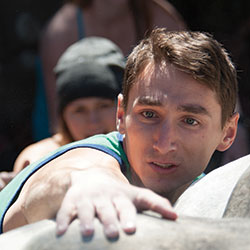 Typically, a bouldering problem involves no more than a 20-foot ascent. This makes it fairly simple to identify and rate routes by their difficulty. Worldwide, there are two primary rating systems. In Europe, the Fontainebleau, or “Font” scale is preferred, while in North America, the V scale is used.
Typically, a bouldering problem involves no more than a 20-foot ascent. This makes it fairly simple to identify and rate routes by their difficulty. Worldwide, there are two primary rating systems. In Europe, the Fontainebleau, or “Font” scale is preferred, while in North America, the V scale is used.
The Font scale got its name from the Fontainebleau climbing region in France. The V scale was named for John Sherman, a notorious climber whose nickname was Vermin. Sherman referred to his V-Scale as “an ego yardstick” he and his friends would use to compare their feats. In both scales, the higher the rating, the more difficult the problem.
Both the Font Scale and the V Scale are open ended, allowing for advances in technique and skill sets in the future. Currently, the most difficult route rated on the V Scale is a V-16, but somewhere, someone may find and climb something more difficult.
Rating the competition
In competitions like the Triple Crown, problems are rated and assigned a point value. The higher the rating on the V Scale, the higher the point value. At Horse Pens 40, the most difficult routes were rated V11, with a few rated V$$$, indicating a cash prize for solving the problem. The highest point value, placed on a problem named “The Seam” was 10,000. The next highest, named “Sun Wall,” was 3,000.
At the Triple Crown, teams from colleges as well as various gyms were represented, but the competition was on an individual level within categories, as opposed to a team competition. Competition categories included both Male and Female Novice, Intermediate, Advanced, and Open. The Unisex Categories included Junior: 12 and under; Ancient Hard Person: 35 years and up; Stone Master: 45 years and up and Star Chaser. The Star Chaser category was open to all ages.
Climbers are placed in the various classes based on their experience and performance history. If a climber is registered as a novice, but their performance at the tournament indicates that they should be rated an intermediate climber, they are moved to the intermediate pool, and scored with the intermediate climbers.
On the Triple Crown website (triplecrownbouldering.org), the spirit of the event is summed up in one line. “Space is limited, and we want only excited climbers who encourage each other.” At Horse Pens 40, everyone had that objective in common. One mother commented that her daughter had been climbing for six years, and she had never seen a more encouraging, enthusiastic group of people anywhere. Everyone seemed to want the other climbers to succeed. Eager to spot, coach, cheer and console characterized the climbers at every problem.
In many formal climbing competitions, coaching is strictly forbidden. This is not the case in the Triple Crown. Climbers are given encouragement and direction from spectators and spotters as they climb. Each new move is cheered, and when one “tops out,” the applause is generous.
Editor’s Note: The Triple Crown will return to Horse Pens 40 the weekend of November 19, 2016. Spectators are welcome. It is a family friendly event, so bring your children. Camping is available, or simply make it a day trip. You may leave with an insatiable urge to climb a rock.


































































































